Overview
This tutorial demonstrates how to generate content for a local plumbing business that offers Bathroom Design, Planning and Installation services.
The business offers these services across the West Midlands county in the United Kingdom.
Prerequisites
We’ll be using a specific Theme and Plugins in this tutorial, but you’re free to use any Themes or Plugins as part of your site building process.
- Your server meets all hosting requirements and is configured correctly
- WordPress: Latest Version
- Theme: WordPress Twenty Nineteen
- Plugins:
Planning
To maximise our search engine presence, make it clear to customers the services that are on offer, as well as if those services are available at the customer’s location, we’ll want to generate content comprising of all service and location combinations.
To do this, we will use Page Generator Pro’s Keywords functionality:
Keywords can be seen as template tags, with each Keyword comprising of one or more Terms.
For example, we might have a keyword called service, describing the services that our plumbing business offers. Its terms could be:
- bathroom installations
- fixing leaks
- central heating installation
There’s no limit to the number of terms a Keyword can have.
Keywords are then used throughout your Content Groups. A Content Group defines a content template, from which Page Generator Pro will generate your Pages, Posts and/or Custom Post Types.
For our local plumbing business, we would create two Keywords:
- service: listing the services that the plumbing business offers,
- location: listing the locations that the plumbing business offers their services in.
Once we’ve created those two keywords, we then want to produce Pages that describe both the services and locations that the plumbing business operates in.
To do this, we will use Page Generator Pro’s Content Groups functionality:
The Generate Content section allows you to define one or more Content Groups (or Content Templates), which generate / produce Pages, Posts or Custom Post Type content.
Each Content Group you create is unique, and comprise of the Keywords, content and generation settings, such as the Post Type and number of Pages to generate.
You might use multiple Content Groups for different sections of your web site. For example, you might have one Content Group for generating Pages about the services your business offers for a list of locations, and a second Content Group for drip-fed blog posts.
From your Content Group, you’ll use the Generate functionality to then make Page Generator Pro generate your Pages, Posts or Custom Post Types.
Creating the Service Keyword
To create the service Keyword, navigate to Page Generator Pro > Keywords in the WordPress Administration menu:
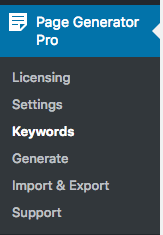
Click the Add Keyword button below the Page Generator Pro title, which can be found towards the top of the screen:
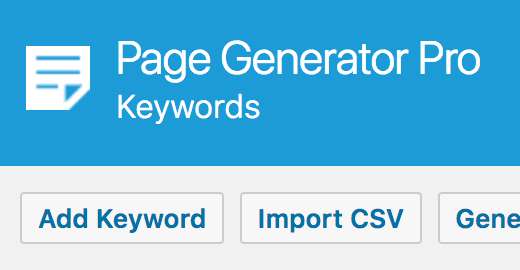
The Keywords form will then be displayed, where you can define the following options:
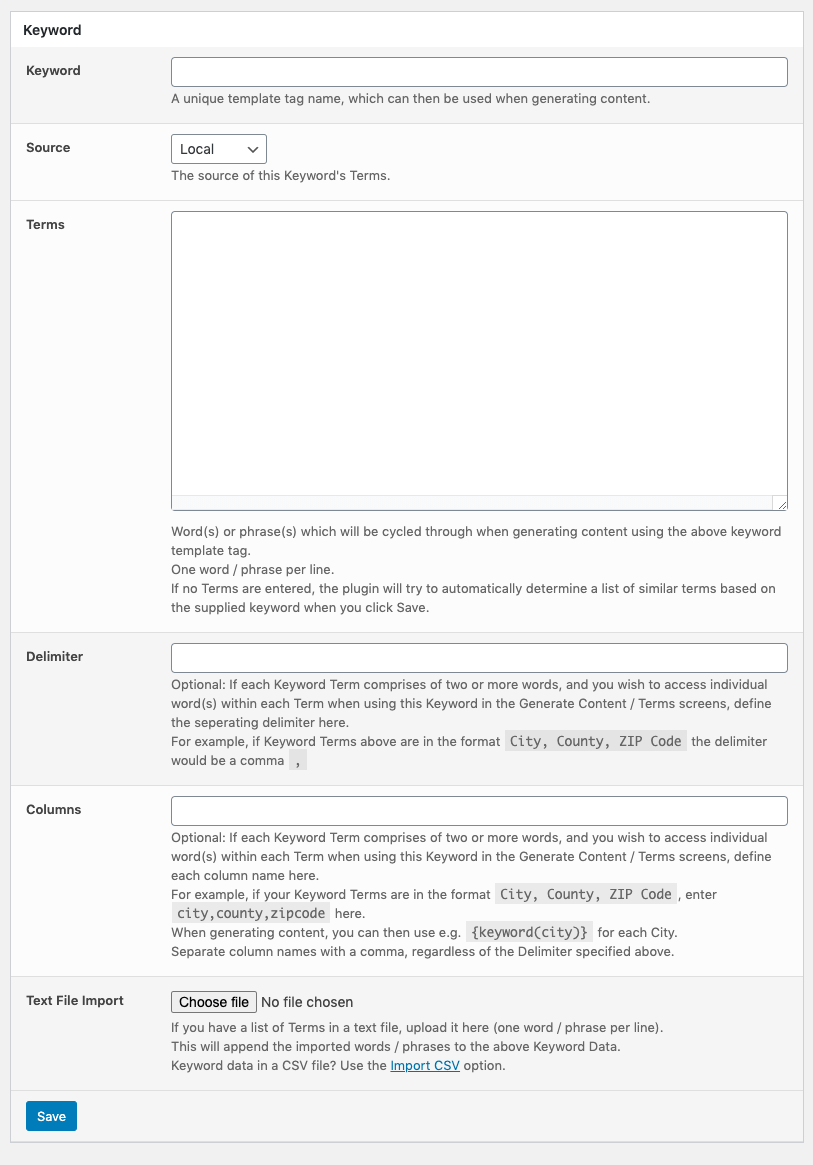
- Keyword:
- This is the unique template tag that you’ll use in the Content Group when defining and generating content.
- For our services, set this value to service
- Source:
- This determines where the Terms will be defined.
- As we’ll be storing the Terms in this Keyword, select Local
- Terms:
- This is the list of words or phrases that will be cycled through when generating content that contains this Keyword.
- Each word or phrase is on its own line.
- We want to think of as many ways that customers might describe our services when searching for them, as well as the services that the business offers. On that basis, we’ll set the Terms to:
- Bathroom Design and Planning
- Bathroom Installations
- Bathroom Remodelling
- Bathroom Plumbing
- Bathroom Shower Installation
- Bathroom Bath Installation
- Bathroom Flooring Installation
- Bathroom Underfloor Heating Installation
Don’t worry about the other fields for now.
Click the Save button.
A notification will be displayed confirming that the Keyword saved successfully.

Creating the Location Keyword
For the location Keyword, we could repeat the same process as we did when defining the services keyword. This would mean manually entering a list of locations that the business serves.
However, this would be time consuming and possibly inaccurate, because we would need to:
- Find a list of all locations within our service area
- Ensure that each location is accurate
- Manually enter each location into the keyword
Instead of doing this manually, we can use Page Generator Pro’s Keywords: Generate Locations functionality:
Page Generator Pro allows you to automatically produce location based Keywords. These keywords contain a list of locations (terms), based on some basic criteria that you provide – for example, all cities within a region / state, or all ZIP Codes in a radius of a starting point.
To create our location keyword, navigate to Page Generator Pro > Keywords in the WordPress Administration menu:

To add a new Location Keyword, click the Generate Locations button below the Page Generator Pro title, which can be found towards the top of the screen:
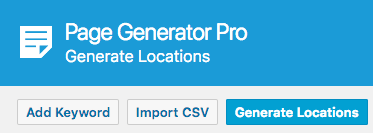
The Generate Locations form will then be displayed, where you can define the following options:
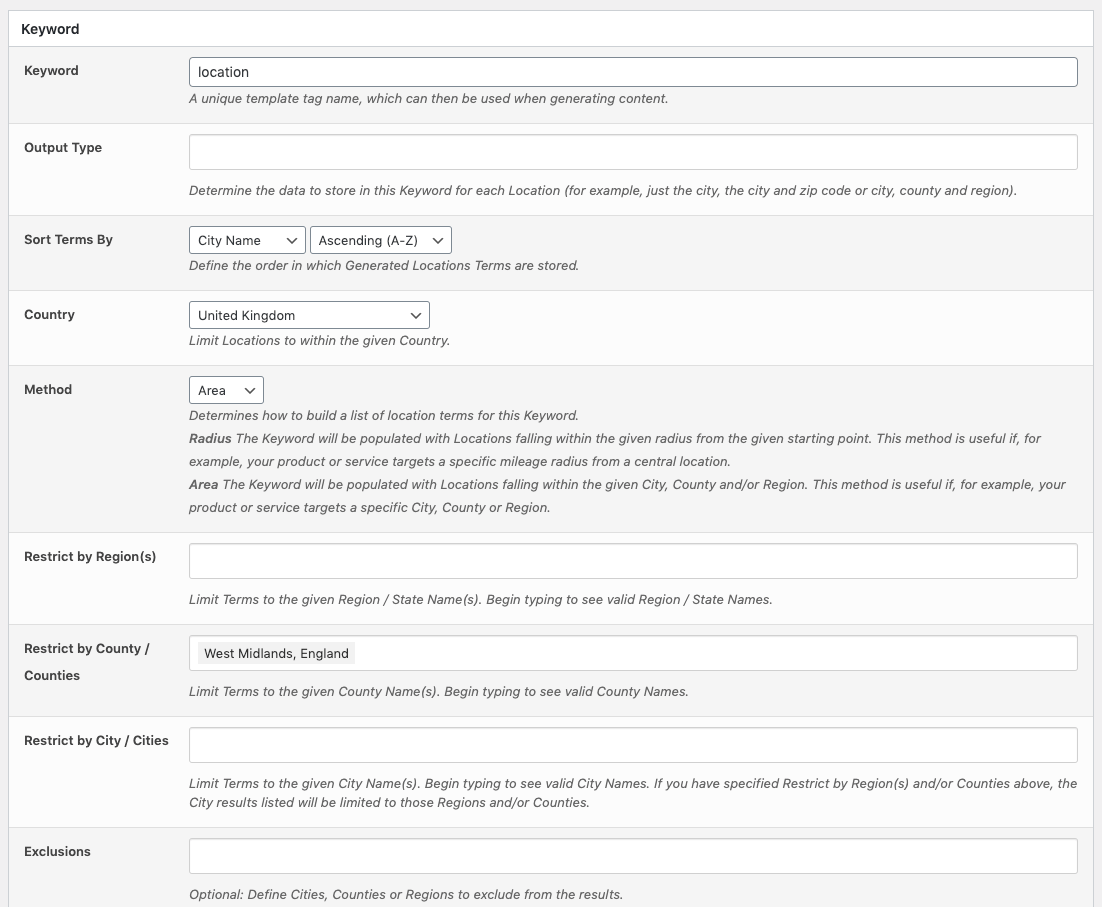
- Keyword:
- This is the unique template tag that you’ll use in the Content Group when defining and generating content.
- For our locations, set this value to location
- Output Type:
- The Output Type defines the data that you want to include for each Location, stored as a Term in this Keyword.
- We can select from any of City, County, ZIP Code and Region.
- Click inside the Output Type field, and select ZIP Code from the dropdown list. This will then include the ZIP Code for each Location, stored as a Term.
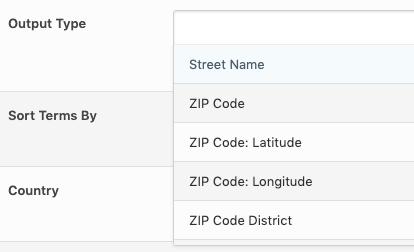
- Click inside the Output Type field again, this time selecting the City option from the dropdown list. This will then include the City for each Location, as well as the ZIP Code, stored as a Term.
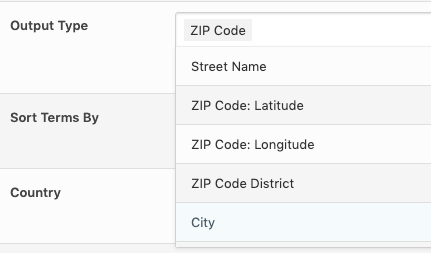
- Click inside the Output Type field a final time, and select County from the dropdown list.
- Sort Terms By:
- The first dropdown option allows us to choose the order that Terms are stored against this Keyword. We’ll work through the ZIP Codes alphabetically, so select the ZIP Code option.
- The second dropdown option allows us to choose whether to order the Terms alphabetically in ascending or descending order. We’ll work through the ZIP Codes in ascending alphabetical order, so select the Ascending (A-Z) option.

- Country:
- Select United Kingdom from the dropdown list
- Method:
- The area method allows us to fetch every location based on the restrictions that we define. This is useful if our business operates within a specific geographic boundary, such as a City, County or Region.
- The radius method allows us to fetch every location within the given radius of a starting point. This is useful if our business operates on a call out basis within a specific distance of its premises.
- For this tutorial, we’ll choose the Area option, assuming that our business operates within a geographical area.
- Restrict by County / Counties:
- As we want to target all locations in the West Midlands, which is a county in the UK, we’ll start typing West Midlands into the Restrict by County / Counties field.
- After a few seconds, West Midlands, England will appear in the dropdown.

- Click this option, so it is added to the field. This means that locations will only be added to this Keyword that are within the West Midlands county of the UK.
- We could add further counties here if, for example, the business operates in multiple Counties. If your business operates within specific Cities, you can use the Restrict by Cities option instead.
With our form complete, click the Generate Keyword with Locations button.
The on screen progress modal will be displayed, whilst the Plugin populates the keyword with the list of locations.

A notification will be displayed confirming that the Location Keyword was generated and saved successfully.

Creating Content
With our service and location keywords defined, we now need to build our content.
To do this, we will use the Generate Content functionality:
The Generate Content section allows you to define one or more Content Groups (or Content Templates), which generate / produce Pages, Posts or Custom Post Type content.
Each Content Group you create is unique, and comprise of the Keywords, content and generation settings, such as the Post Type and number of Pages to generate.
To create our Content Group, navigate to Page Generator Pro > Generate Content in the WordPress Administration menu:
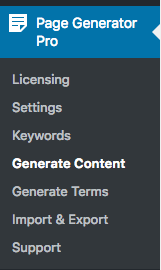
To add a new Content Group to Page Generator Pro, click the Add New button below the Content Groups title, which can be found towards the top of the screen:
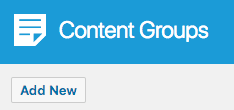
You will then be presented with a screen similar to the one used to edit your WordPress Posts and Pages:
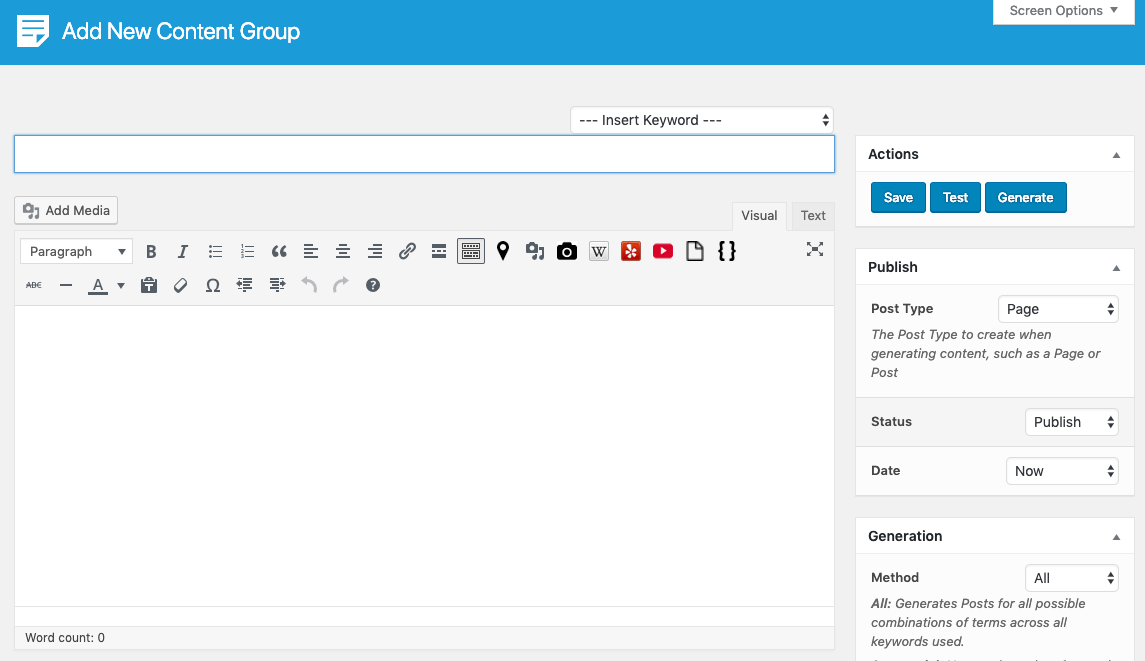
Title
Let’s start by defining the title that we want for each of our Pages. As we’re targeting each service and location, we want our Page Title to include both of these keywords.
Click on the Insert Keyword dropdown on the top right of the Title field, and click service

This will insert the {service} keyword into the Title field:

You can also start typing in the Title field, and a list of matching Keywords will be displayed. Let’s finish the Title by starting to type in location, and then clicking the {location} keyword from the list of results:
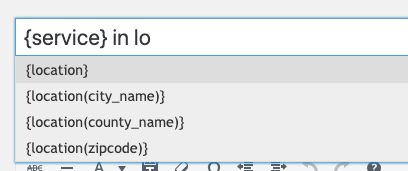
The service and location keywords will be replaced by a unique term for each Page that’s generated. If we take the first term from our service and location keywords, the first Page generated would use the following terms:
| Keyword | Term |
|---|---|
| service | Bathroom Design and Planning |
| location | B10 0AB, Birmingham, West Midlands |
Our Title (for the first generated Page) will read:
Bathroom Design and Planning in B10 0AB, Birmingham, West Midlands
Content
Next, let’s write some content about the service and location. In this tutorial, we’ve gone ahead and produced some content below, which you can copy and paste into the Text Editor from https://gist.githubusercontent.com/n7studios/8e8fe6074d325b559ec4962a055b102d/raw/b4f81e7060d06ade8e7c51def60c83a61dc3891a/page-generator-pro-tutorial-content.htm
Click on the Visual tab, to preview the content:
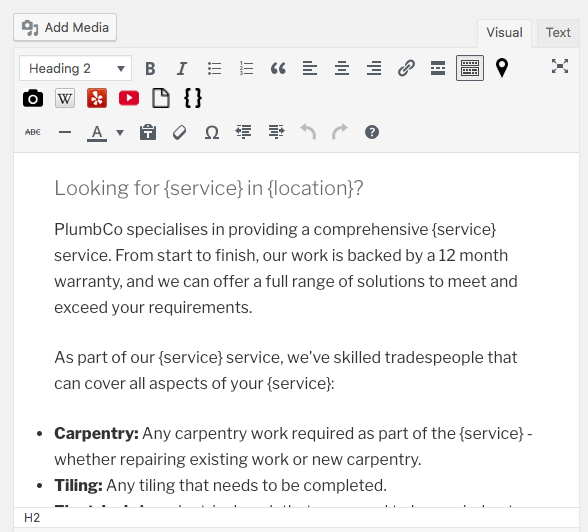
Description
The description isn’t displayed anywhere on the generated content, and it is not required. However, it’s useful as an internal description about the content if you have several Content Groups defined in Page Generator Pro.
For this tutorial, we’ll describe this group as Bathroom Services in West Midlands:

Permalink
By default, WordPress will generate a Permalink based on the Title. However, we can control the precise Permalink used by manually enter a Permalink now.
To do this, enter {service}-{location} into the Permalink text field:

Publish
By default, Page Generator Pro is set to publish content as Pages – but just to be sure, check that the Post Type option is set to Page:
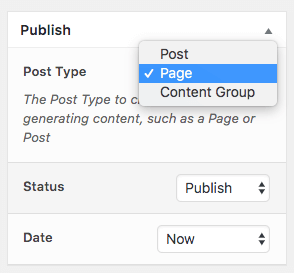
Generate
There are a few different ways that we can generate content, each of which are based on the keywords that we’re using:
| Method | Description |
|---|---|
| All | The All method generates Pages for all possible unique combinations of the keywords specified in the Content Group. This would ensure that every service and location combination has its own unique Page. |
| Sequential | The Sequential method honors the precise order of each keyword’s terms. This would mean that the first service and first location would be used for the first page, the second service and second location would be used for the second page, and so on. |
| Random | The Random method generates Pages, choosing a term from each keyword at random for each Page that is generated. |
Given that our plumbing business covers all listed services in all locations, we want to use the All method.
Overwrite
The Overwrite option allows us to overwrite existing Pages that were previously generated by this Group, matching the Permalink. This is useful if we need to re-generate our Pages because we fix a typo, or change the content, and don’t want to end up with duplicate Pages describing the same service and location.
Set this option to Yes
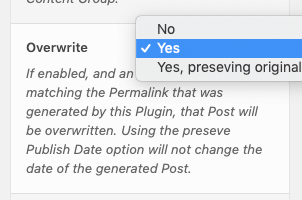
Actions
With our Title, Content and Permalink completed, plus the publish and generation settings confirmed, let’s save our Content Group before starting content generation.
In the Actions box, click the Save button:
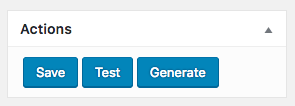
The screen will update, confirming that the Content Group has been published (or updated, if we’re saving an existing Content Group):
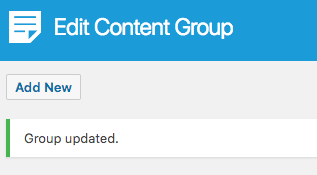
Testing Content
With our Content Group saved, we’re almost ready to generate our content.
Before we do this, it is be a good idea to test the content and settings by generating a single Page in draft mode. This ensures that the Page isn’t made available to web site visitors, in case we spot any issues and need to change settings or content in our Content Group.
To do this, in the Actions box, click the Test button:

Confirm that we want to generate a single Page in draft mode by clicking OK.
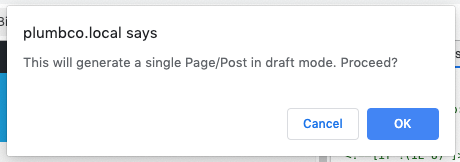
After a few moments, the screen will update, confirming that a Test Page has been generated. The notification also tells us the terms that were used to replace the keywords:

Let’s click the link in the notification, which takes us to the draft Page:
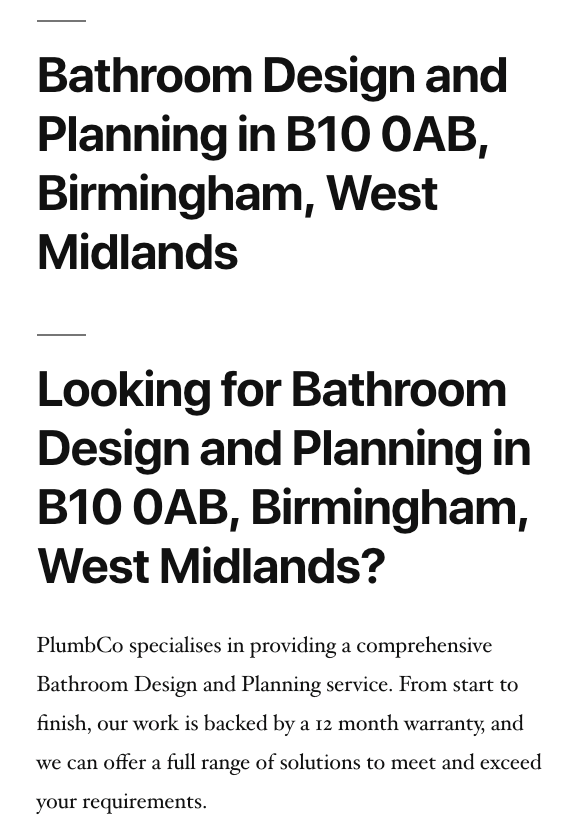
Improving the Content
Whilst the content looks good, there are a few areas we could improve on. Let’s go back to the Content Group’s edit screen, and make some improvements.
Extracting Keyword Term Subsets
Whenever we’re using the location keyword, we’re getting the full term. For example, our Title is Bathroom Design and Planning in B10 0AB, Birmingham, West Midlands. This is not the most user or SEO friendly title, so let’s look at extracting keyword term subsets to produce a better title.
When we created our location keyword, some additional fields were also automatically completed for us. If we go to Page Generator Pro > Keywords, and click on the location keyword, you’ll see two fields: delimiter and columns:
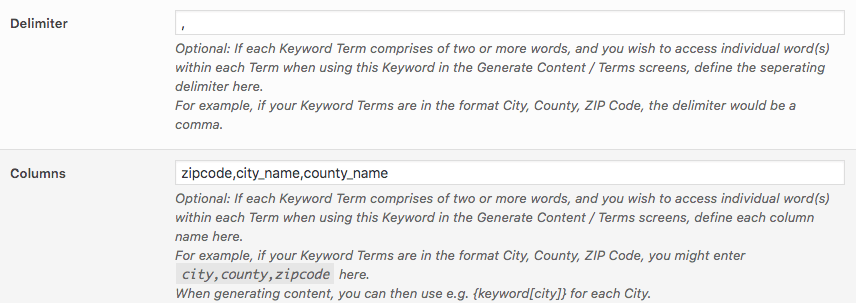
These correspond to the location terms listed, namely:
- Delimiter: The character separating words for each Term,
- Columns: Column names corresponding to each delineated word in the Terms, based on the Delimiter.
In our location keyword, you’ll see that we have the following:
- Delimiter: ,
- Columns: zipcode,city_name, county_name
Going back to our Content Group, this means that we can control which parts of each Term are output when we use our location keyword.
For the Title, we only want the City and ZIP Code, as the County will always be the same (i.e. always the West Midlands). Using the columns defined in our location keyword, we can update our Title field to read: {service} in {location(city_name)}, {location(zipcode)}.
To do this, delete the existing {location} text in the Title, and start typing location. You’ll see that the dropdown list of keywords contains both our city name and zipcode subsets:

Select the city name, and then type again to select the zip code, so we produce the following title:
This will produce a more user-friendly Title:
Bathroom Design and Planning in Birmingham, B10 0AB
Let’s also update the first title in the Visual Editor in the same way, replacing Looking for {service} in {location}? with Looking for {service} in {location(zipcode)}?
Adding Google Maps
For Pages to be considered for inclusion in search engine indexes, it’s important that the content comprise of more than a few paragraphs of text. We can enhance the content with some of Page Generator Pro’s shortcodes.
Let’s start by adding a Google Map illustrating the location where the service is offered.
The Google Map shortcode inserts a Google Map, Satellite Map, Driving Directions or Street View into the content, depending on the shortcode’s parameters.
We’ll add this after the first paragraph, by clicking at the end of the first paragraph and pressing Enter, to create a new paragraph for our Google Map:
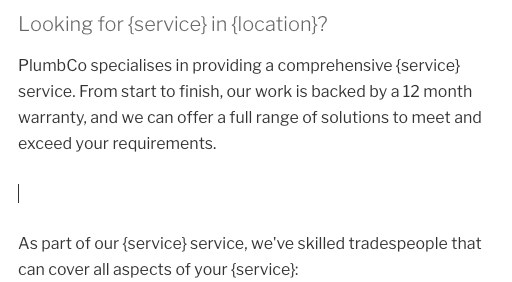
Next click on the black marker icon in the toolbar of the Visual Editor:
![]()
In the modal dialog window that appears, we have several options to complete:
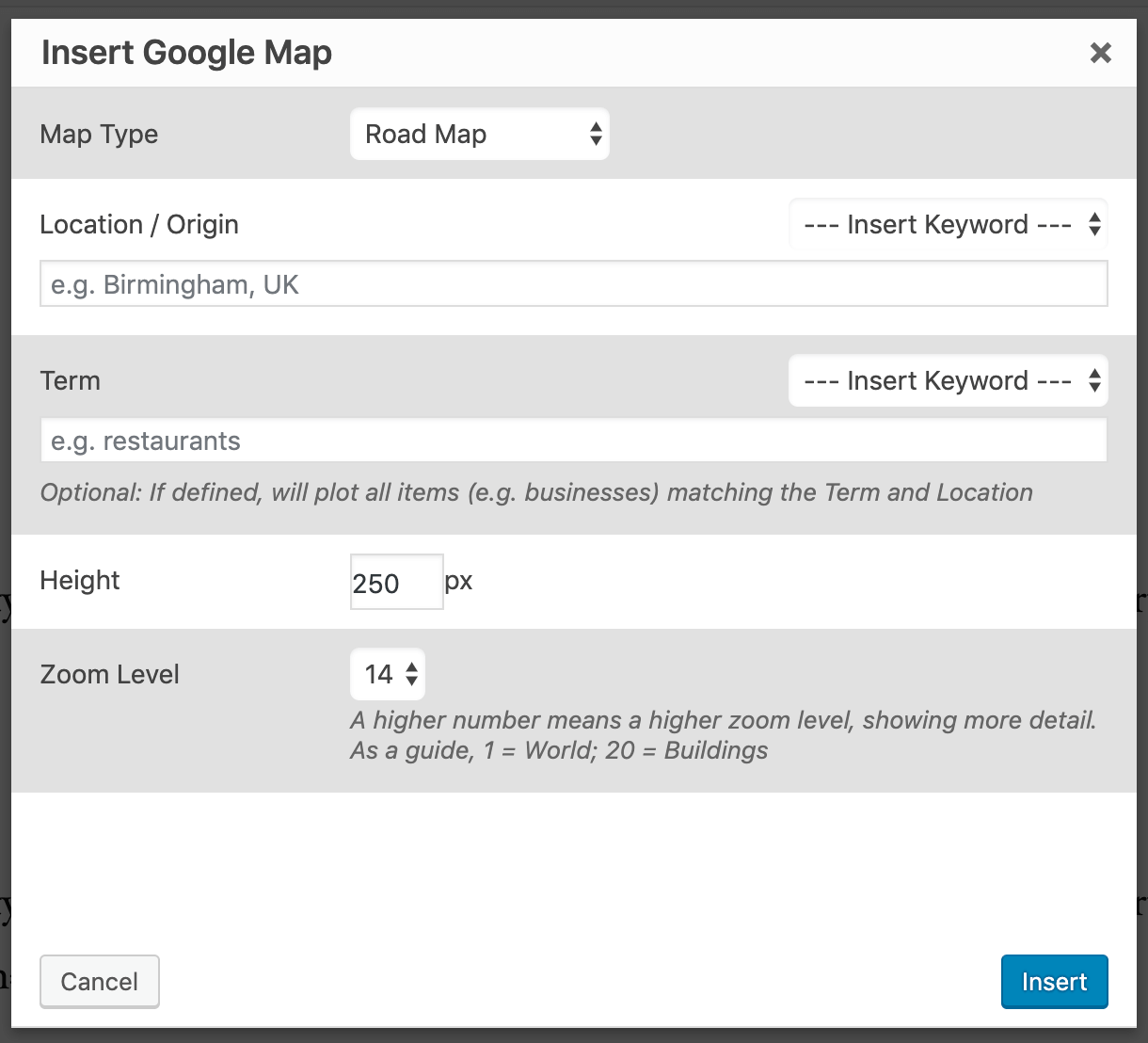
- Map Type: We’ll use a standard Road Map.
- Location:
- This is the location to display on the Map. We could manually enter a location here, but we can also use our location keyword, just as we did in the Title and Content.
- Using either the Insert Keyword dropdown, or by typing into the Location field, select the {location(zipcode)} keyword. This will then use the ZIP Code.
- Height: If we need the map’s height on the computer screen to be taller, we can increase the default 250px. Let’s change this to 350px.
- Zoom Level: As we’re displaying a postal code / zip code area on the map, we want to show some detail by zooming in more than the default setting. Let’s change the Zoom Level to 16.
Click the Insert button, and you’ll see that a WordPress Shortcode has been added where we previously had a blank space:
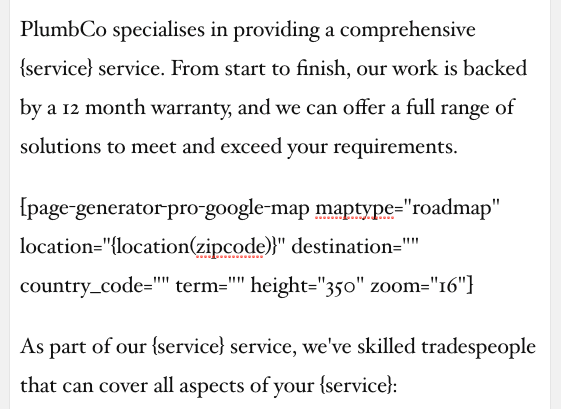
Adding Images
We can also add relevant images from third party sources, to further enhance our Content and SEO.
Before the Costs heading, add a blank paragraph, and then click on the green Pexels icon in the toolbar of the Visual Editor:
![]()
In the modal dialog window that appears, we have several options to complete across two sections: Search Parameters and Output.
The Search Parameters determine the image content that we’re looking for, as well as the image’s size and orientation: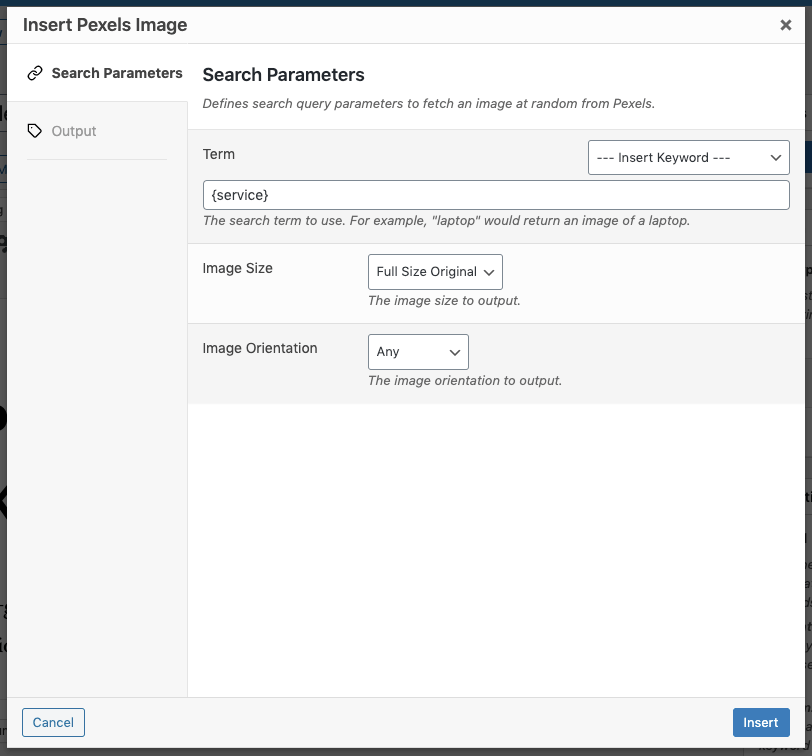
- Term:
- The Term is the search query that is used when Page Generator Pro searches for images on Unsplash (a free stock photography site).
- As we want our images to be relevant to the content we’re producing, we can use keywords here.
- Let’s go ahead and enter {service} into the Term field.
- Image Size:
- Whilst most Themes will automatically scale the image to fit on the screen, we can choose a size that isn’t too large to result in slow page loading times.
- Choose the Full option.
- Image Orientation:
- If we wanted a specific orientation of image, we could specify it here.
- For now, leave this option set to any.
The Output section determines how the image should be output in our content. Click the Output tab to see the following options:
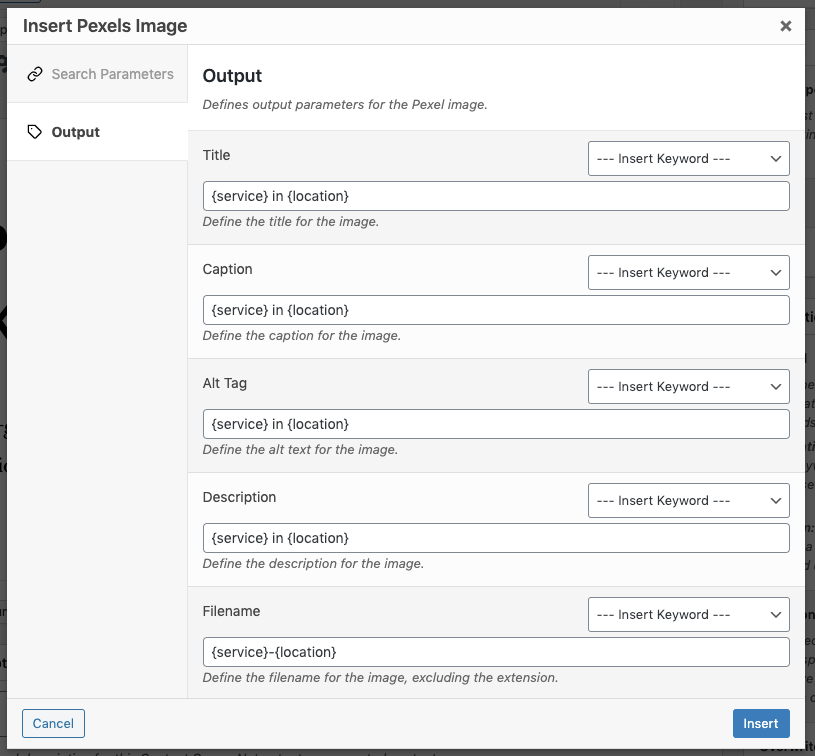
- Title:
- The title isn’t used by many Themes, but it’s useful to set it when subsequently searching within the Media Library.
- Let’s go ahead and enter {service} in {location} into this field.
- Caption:
- The caption may be used by your Theme as part of the image output.
- Let’s go ahead and enter {service} in {location} into this field.
- Alt Tag:
- The alt tag is used to define the alt tag assigned to the image that’s inserted into the content. This should describe the image, so in most cases matching the Term is best.
- This is also useful for SEO and Google Image Searches.
- Let’s go ahead and enter {service} in {location} into this field.
- Description:
- Again, the description isn’t used by many Themes, but it’s a good habit to define this should you later switch Theme or need to make use of image descriptions.
- Let’s go ahead and enter {service} in {location} into this field.
- Filename:
- Similar to the Alt Tag, the filename should relate to the content we’re generating, and
- This is also useful for SEO and Google Image Searches.
- Let’s go ahead and enter {service}-{location} into this field.
- Don’t worry about spaces and non alphanumeric characters in your Service or Location Keyword Terms; they’ll be replaced to produce a valid filename.
- We don’t need to add a file extension (.jpg, .png etc); the Plugin will handle this for us.
Click the Insert button, and you’ll see that a WordPress Shortcode has been added where we previously had a blank space:
Adding Spintax
Another method we can use to enhance the uniqueness of each generated page is to use Spintax.
Page Generator Pro supports Content Spinning, which allows you to generate variants of strings or paragraphs within your content for each generated Page – without using the Keywords system – in a random fashion.
For example, a sentence might be:
Writing content is a lot of fun.
Using spintax, we can use:
{Writing|Creating} {content|articles} is a {lot of fun|rewarding experience}
Page Generator Pro will then, at random, generate a variation for each generated Page. In this case there are 8 possible variations:
Writing content is a lot of fun
Creating content is a lot of fun
Writing articles is a lot of fun
Creating articles is a lot of fun
Writing content is a rewarding experience
Creating content is a rewarding experience
Writing articles is a rewarding experience
Creating articles is a rewarding experience
Applying this to our content, we can replace some words with spintax. Let’s apply some spintax to our first paragraph:
PlumbCo specialises in providing a {comprehensive|complete|thorough} {service} service. From start to finish, our work is backed by a 12 month warranty, and we can offer a full range of solutions to meet and {exceed|eclipse|better} your {requirements|needs|expectations}.
Adding Block Spinning
We can also use Block Spinning, which allows us to generate unique paragraphs of content – not just words.
For example, a sentence might be:
Writing content is a lot of fun.
Using block spinning, we can define variants of that sentence:
#p# #s# Writing content is a lot of fun. Creating articles is a rewarding experience. #/s# #/p#
Page Generator Pro will then, at random, generate a variation for each generated Page. In this case there are 2 possible variations:
Writing content is a lot of fun.
Creating articles is a rewarding experience.
Applying this to our content, we can replace our modified first paragraph with block spintax (and yes, spintax within block spintax works!):
#p#
#s#
PlumbCo specialises in providing a {comprehensive|complete|thorough} {service} service. From start to finish, our work is backed by a 12 month warranty, and we can offer a full range of solutions to meet and {exceed|eclipse|better} your {requirements|needs|expectations}.
Looking for {service} services? PlumbCo has you covered. Our {comprehensive|complete|thorough} {service} service comes with a 12 month warranty.
#/s#
#/p#
With the changes to our content made, let’s re-test them.
To do this, in the Actions box, click the Test button:

As well as saving the Group, the screen will update, confirming that a Test Page has been generated. The notification also tells us the terms that were used to replace the keywords:

Let’s click the link in the notification, which takes us to the draft Page:
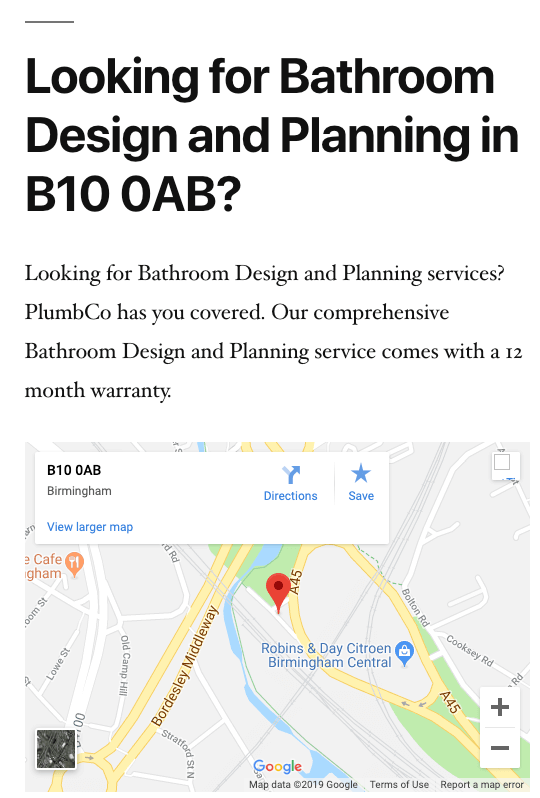
We can now see our changes, including the Google Maps, Images and Spintax.
Adding a Contact Form
With our content defined, we now want to focus on converting visitors to prospects, giving them an actionable next step.
One of the best ways of doing this is to add a contact form to your content.
In this tutorial, we’re using WPForms, but you can use any contact form Plugin that you prefer. If you haven’t already set up a contact form in WPForms, you can follow this separate tutorial.
To add the contact form to the end of the content:
- Click at the end of the last bullet point
- Press Enter twice, to start a new paragraph and close the bullet point list
- Click the Add Form button at the top of the Visual Editor
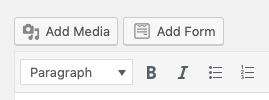
- Select your form from the dropdown list, and click Add Form
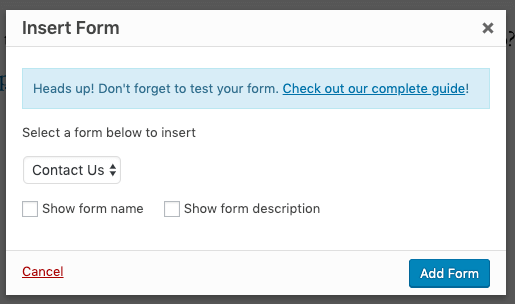
Defining SEO Metadata
With the contact form added, the final step is to ensure that our SEO metadata is correct for the pages that we’ll be generating.
In this tutorial, we’re using Yoast SEO, but you can use any SEO Plugin that you prefer.
When editing the Content Group, the Yoast SEO meta box is displayed:
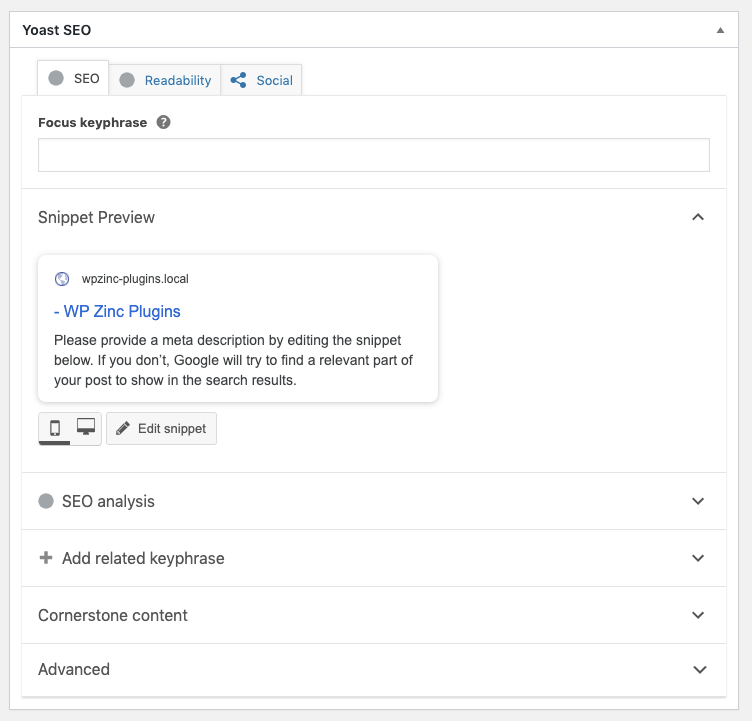
We can edit the following:
- Focus keyphrase:
- It is good practice to define the focus keyphrase, as the Keywords will be replaced by a Term on each generated Page. This means that when we view an individual Page, we can review the score and tweak its content slightly if necessary.
- This will also display the Analysis results for the Content Group, meaning that we can make changes as necessary to improve our content on a Page by Page basis manually, if needed.
- Edit snippet:
- Clicking the Edit snippet button expands the section to allow us to enter the text that we’d like to appear on the search engines.
- In the Meta description field, we can enter:
PlumbCo specialises in providing a {comprehensive|complete|thorough} {service} service - It is good practice to define the Meta Description, as not all Post Types support an Excerpt, which is where the Meta Description might be taken from.
- Keywords will be replaced by a Term on each generated Page, ensuring that we have a valid Meta Description.
SEO Analysis
With the Yoast SEO fields completed, we can now look at the Readability Analysis to see how well our content might perform on the search engines.
Click on the Readability analysis heading in the Yoast SEO meta box.
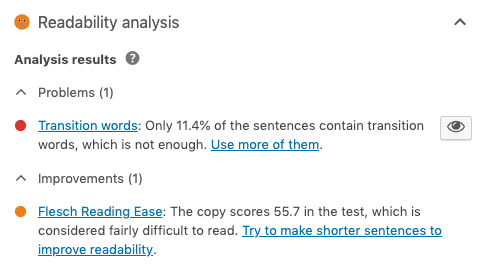
For our content, we’re advised to add more transition words and improve the ease of reading of the content. Let’s go ahead and change the content to match the content below, which you can copy and paste into the Text Editor from https://gist.githubusercontent.com/n7studios/8e8fe6074d325b559ec4962a055b102d/raw/7e5016069789246627800ebeff7feec340283fa3/page-generator-pro-tutorial-content-edited.htm
You’ll notice that both the Transition words and Reading Ease tests are still amber; this is because we’re specifying block spintax and spintax, not all of which will be included in the generated Pages. Therefore we need to perform a final Test generation to see how a completed Page performs in terms of SEO Analysis.
To do this, in the Actions box, click the Test button:

Confirm that we want to generate a single Page in draft mode by clicking OK.

After a few moments, the screen will update, confirming that a Test Page has been generated. The notification also tells us the terms that were used to replace the keywords:

Let’s click the link in the notification, which takes us to the draft Page:

Click the Edit Page link in the WordPress Admin bar (or, if your site does not display this, navigate to WordPress Admin > Pages and edit the draft Page).
When we review the Yoast SEO section, we can see that both Readability analysis and the Focus keyphrase are green:
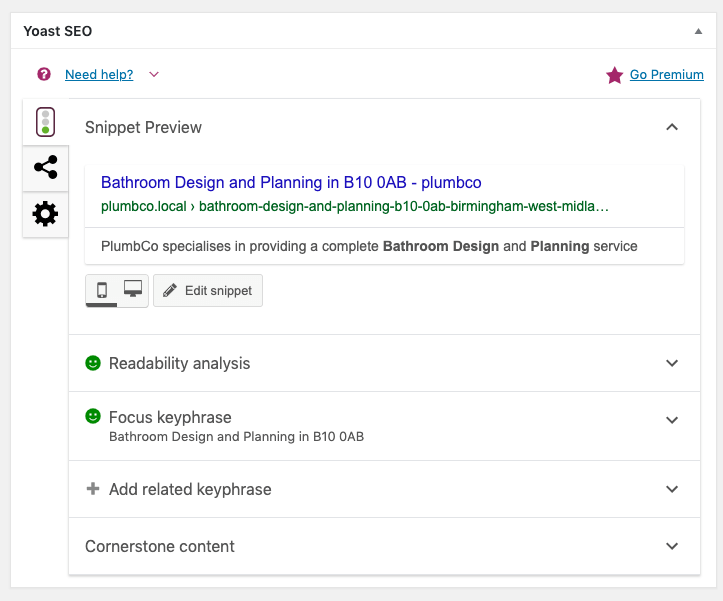
Generating Content
If we’re happy with our content, we can now go ahead and generate all of our Pages. To do this, click the Generate button in the Actions section of the screen:

A new screen will appear, showing a progress bar and log. As each page generates, the progress bar and log will update:
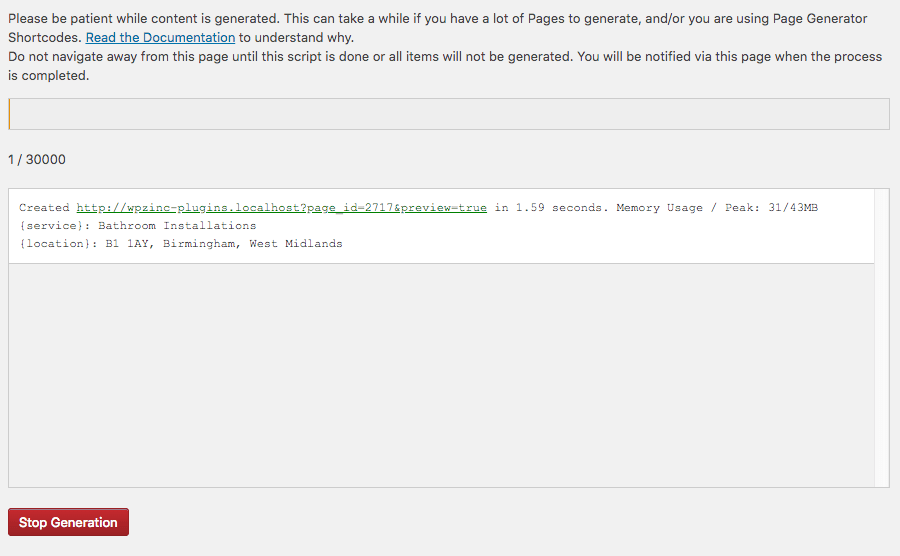
Conclusion
This tutorial has covered the basics of using Page Generator Pro to:
- Define services and locations that a business offers,
- Produce a Content Group (template) comprising of Page content that we want to output across all generated Pages,
- Applied Keywords, Spintax and Block Spintax to produce more unique content for each of our generated Pages,
- Familiarised ourselves with how to Test Generate a Page,
- Used Shortcodes to add rich media covering Google Maps, Images,
- Used a contact form plugin, WPForms, to provide visitors with a direct way to enquire about the business’ service,
- Used the Yoast SEO plugin to define SEO metadata and perform SEO analysis.
There’s much more that Page Generator Pro can do, so be sure to check out the Documentation and any other Tutorials.